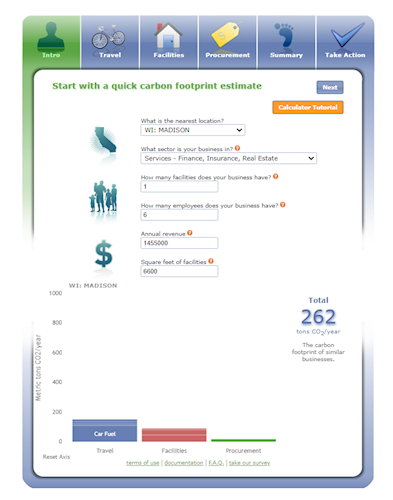
In order to optimize efficiency, businesses must first quantify their emissions and determine their sources. Businesses create greenhouse gas emissions through both consumption and production because they create products and services that generate emissions after the point of sale; emissions fall into the following categories:

Large businesses typically deploy a team of staff or consultants to calculate and track corporate emissions. Smaller entities can start by using an online calculator to estimate emissions. As illustrated in the image to the right, this calculator estimates Scope 1 and 2 emissions along with specific Scope 3 categories.
Once you've calculated your emissions you can identify the best opportunities to reduce those emissions. Many entities are setting net zero goals, which means eliminating or offsetting all greenhouse gas emissions. Learn more about the various ways entities define net zero from our primer.
Getting to net zero is a process. As part of this process you will need to examine your supply chain and work with suppliers to reduce the emissions associated with the goods you buy. And you will also want to think about the life cycle of the products you create. Can you, for example, make it easier for consumers to recycle your product?
Eliminating all emissions is rarely possible. Fortunately, companies can further reduce their environmental foot print by purchasing carbon offsets. Learn more about carbon offsets via the 2020 Nelson Institute Earth Day webinar series for businesses.
Business use resources to create valuable products and services. Businesses thrive when they match the resources used to the products sold. Likewise, business are most profitable when they don't use more energy or water than necessary for operations. Optimizing resource use reduces your operating costs and improves profitability. Below are resources to help business maximize their efficiency and reduce waste:
For more discussion on strategies to manage resource use, check out the business-specific webinars that were part of this year's Nelson Institute Earth Day Conference.
Ten years ago almost three-quarters of Wisconsin's electricity came from coal but by 2050 experts predict that our electricity will be 100% renewable. Electricity is an increasingly clean fuel, which means transitioning activities, such as heating buildings, or moving goods, from fossil fuels to electricity can reduce corporate emissions.
One way to reduce emissions is to transition your light-duty vehicles from gasoline to hybrid electric or battery-electric options. Wisconsin Clean Cities has resources to help you calculate savings and identify vehicles that will work for you.
If you are considering a new facility, explore opportunities to be net zero energy or net zero carbon. An all-electric facility with on-site renewable energy can be net zero energy while a highly efficient facility that utilizes off-site renewable energy or carbon offsets can achieve net zero carbon status. Businesses are already making this transition with geothermal technology - learn more here. We highlight some aspects of both options, along with resources, in this primer. For more details on building a net zero building, check out the City of Eau Claire's Net Zero Design Guide.
Your employees are a critical part of your operations; be sure to involve them in your efforts to reduce emissions!
Initiating a green team is a great way to engage employees. Sustain Dane offers a Green Team Roundtable where your team can connect to other Green Teams, to share ideas and build momentum.
For examples of ways other organizations leverage green teams, check out the case studies on the Wisconsin Sustainable Business Council website.
Employee travel contributes to your emissions, including both employee commuting and travel to attend meetings and other work-related events. Take action to reduce both kinds of emissions:
COVID-19 has prompted a lot of individuals and companies to re-think their travel habits. This is a great time to work with your employees to establish a new normal that is healthier, less stressful, and better for the environment.
Every day your employees make hundreds or even thousands of decisions that affect your business. Will they turn off lights and equipment when not in use? Will they toss the paper in the nearby trash can or find a recycling bin? Will they seek out suppliers that meet your green critieria?
To facilitate good workplace decisions make it easy for people to make smart choices. A clearly-labeled recycling bin makes separate items that can be recyled easy. Clear messages about equipment usage (e.g., "always turn off your monitor if you'll be away from your desk for five minutes or more") clear up any confusion about what to do. Then, celebrate success; simple acknowledgements can reinforce important habits. Thank a colleague for turning off the lights as you leave the conference room or provide treats for a team that's doing a great job recycling. Your acknowledgement will reinforce good habits and encourage others to adopt those habits as well.
You can also influence what employees do by creating social norms around those practices. To learn more, check out the webinars on the Cool Choices website.
In addition increasing efficiency, you can power your operations with renewable energy. You can achieve this by:
Learn more below to decide which opportunity is best for your business.
Although most organizations typically install solar electric (photovoltaic) systems when transitioning to renewable energy, a wind turbine might also be an option if you are in a rural setting within Dane County.
Multiple private solar installers are active in Dane County. See a list of vendors from the Solar Energy Industries Association. The Midwest Renewable Energy Association's annual Energy Fair is a great opportunity to talk to installers and learn about renewable energy technologies. And if your business is in Madison, the MadiSUN program is a great resource. Additionally, Focus on Energy also offers information and some incentives for solar energy projects.
Check out our Clean Energy Map to learn a bit about other organizations in Dane County that have already installed solar energy systems.
Farmers may be interested in AgriSolar options where solar panels co-exist with farming operations.
This is a good time to consider renewable energy because of the funding available under the Inflation Reduction Act.
An organization can also opt to purchase green power from your utility for a small premium. This option works well for organizations that rent their space or have facilities that are not suitable for solar. Learn more about your utility's green power offerings:
In our Climate Action Plan we set a goal of 1200 MW of solar installed in Dane County by 2030. Whether you install a system on your own house or buy green power from your utility, you are helping us achieve this important goal.
Talking about your emissions reduction strategies is critical. When businesses talk about their efforts, customers and employees listen. Almost 7 in 10 people in the US and Canada prefer sustainable brands. More, research shows that consumers follow through on this purchase and are more likely to buy sustainable products. Similarly, your employees care about what you are doing; more than 8 in 10 employees want to work for a company that's environmentally and socially responsible.
Your story can help motivate other businesses to do more. So talk about your efforts! While you're at it, we're happy to talk up your efforts and use you as an example for others, so submit a story to us. After all, that's how we make change happen.